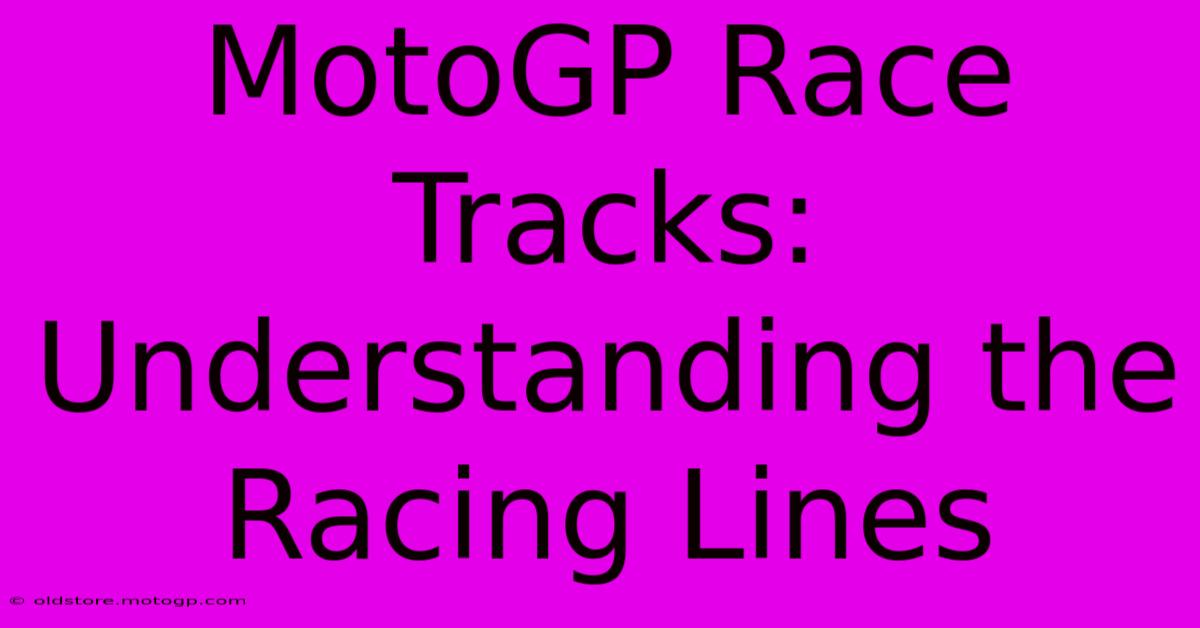MotoGP Race Tracks: Understanding The Racing Lines

Table of Contents
MotoGP Race Tracks: Understanding the Racing Lines
MotoGP, the pinnacle of motorcycle road racing, demands precision, skill, and a deep understanding of the tracks. While raw talent is crucial, mastering the racing line is paramount for achieving optimal lap times and securing victory. This article delves into the intricacies of racing lines on various MotoGP circuits, exploring what makes them effective and how riders utilize them to gain an advantage.
Deconstructing the Perfect Racing Line
The "racing line" isn't a single, rigid path. It's a dynamic, ever-evolving strategy adapted to the specific characteristics of each corner and the overall track layout. Generally, it involves a series of crucial points:
1. Turn-In Point: Setting the Stage
The turn-in point is where the rider initiates the turn. Choosing the correct turn-in point is critical. Too early, and the rider loses valuable speed. Too late, and they risk running wide and losing control. This point is determined by several factors, including:
- Track conditions: Wet or dry, the grip levels dictate the ideal turn-in.
- Tire wear: As tires degrade, riders might adjust their turn-in to compensate.
- Bike setup: Different bike configurations influence optimal entry speeds and lines.
2. Apex: The Heart of the Corner
The apex is the closest point the rider reaches to the inside of the corner. Finding the perfect apex allows the rider to:
- Maximize exit speed: A precise apex ensures a smooth and efficient transition to the track's exit.
- Maintain momentum: This is crucial for minimizing time loss in the corner.
- Optimize tire wear: A well-chosen apex minimizes unnecessary stress on the tires.
3. Track-Out Point: Accelerating to the Next Challenge
The track-out point is where the rider begins to accelerate out of the corner. This section demands careful control and precise throttle application. A smooth track-out is essential to:
- Gain maximum speed: Efficient acceleration out of the corner is vital for lap time improvement.
- Set up for the next corner: The track-out position directly impacts the approach to the following turn.
- Maintain stability: Sudden acceleration can unsettle the bike, so a controlled track-out is key.
Analyzing Specific MotoGP Tracks and Their Unique Lines
Each MotoGP track presents unique challenges. Understanding the specific characteristics of each circuit and its corners is essential for defining the optimal racing line. Let's consider a few examples:
The Fast and Flowing Circuit of Assen: This track is known for its fast corners and technical sections. Riders must maintain momentum through the flowing turns, utilizing a smooth, continuous line to achieve maximum speed. The apex in some corners is surprisingly late, demanding incredible precision and bravery.
The Iconic Curves of Mugello: Mugello features a combination of high-speed straights and challenging chicanes. Riders need to brake hard and late in some sections, achieving a tight turn-in and precise apex to maintain speed through the faster turns. The iconic uphill section needs careful planning and an almost perfect line to keep momentum.
The Technical Challenge of Sachsenring: The Sachsenring, with its tight, technical layout, demands exceptional precision. The racing line here often involves carrying less speed into the corners but utilizing strategic apex placement to optimize the exit speed and navigate the multiple quick direction changes efficiently.
Beyond the Line: Factors Influencing Rider Choices
While the racing line is crucial, it's not the only factor determining performance. Several external elements play a vital role:
- Weather conditions: Rain drastically alters grip levels, necessitating adjustments to the racing line.
- Tire wear and degradation: As the race progresses, tire wear influences the choice of racing lines, often compromising optimal lines for better tire management.
- Opponent's position: Overtaking maneuvers often require deviating from the ideal line to gain a competitive advantage.
Conclusion: Mastering the Art of the Racing Line
Mastering the racing line in MotoGP is a continuous learning process. It demands a profound understanding of physics, track characteristics, and the limits of the motorcycle. While the perfect line is an ideal, constantly adapting to changing conditions and competing against rivals defines the skill of a true MotoGP champion. The pursuit of the optimal racing line is a constant challenge, making MotoGP one of the most captivating and technically demanding motorsports in the world.

Thank you for visiting our website wich cover about MotoGP Race Tracks: Understanding The Racing Lines. We hope the information provided has been useful to you. Feel free to contact us if you have any questions or need further assistance. See you next time and dont miss to bookmark.
Featured Posts
-
From Zero To Hero The Rise Of The Best Motorcyclist
Feb 22, 2025
-
Moto Gp Photoshoot From Grid To Glory
Feb 22, 2025
-
Cota One Day Pass Easy Affordable City Travel
Feb 22, 2025
-
Ride In Comfort F1 Shuttle Austin
Feb 22, 2025
-
Grand Prix Victory Who Earned The Ultimate Prize
Feb 22, 2025
